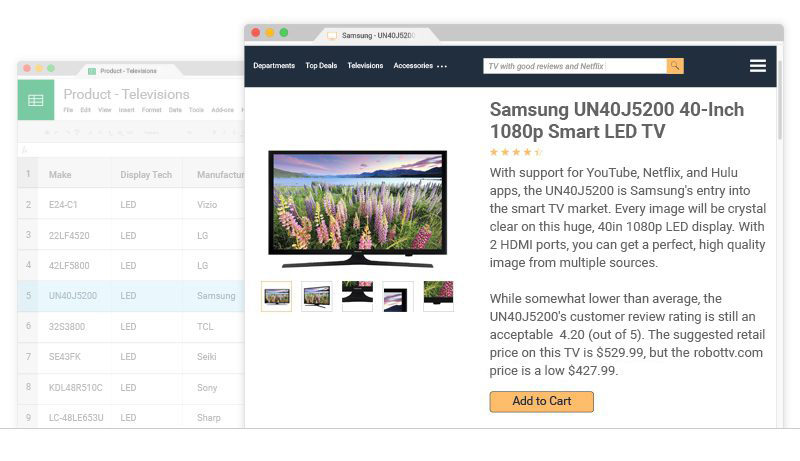Across the virtual landscape of ecommerce companies, it’s common knowledge that there’s a handful of superstore giants (e.g. Amazon, Alibaba, eBay, etc.) that tend to dominate. Of course, they provide a variety of general audience consumer products by the hundreds of thousands because they have the infrastructure to do so.
So how do you get noticed if you’re selling products to a specific market, or you simply want to compete with the heavy-hitters without having a 300,000 member workforce army? It’s time to embrace the power of machine to work smarter instead of relying on feckless battles of brute force.
Enter natural language generation.
Natural language generation (NLG) is a software process that takes structured data and turns it into human-friendly written narrative. While NLG can be implemented for tasks such as corporate earnings reports, fantasy football recaps, and business intelligence summaries, it also has multiple uses within the ecommerce industry.
See more examples of natural language generation implementation
If you have a spreadsheet with your product SKUs with information including item specs (like size, color, and product features), then you have structured data waiting to be fed into an NLG engine. By harnessing the power of natural language generation, you can turn the ecommerce data you already have into beneficial content to be published across your website.

Types of NLG-Ready Ecommerce Content
Category Landing Pages
Many times, category landing pages are easily overlooked when it comes to developing an ecommerce content strategy. If you’re only using category landing pages as a bucket or starting point for narrowing down a visitor’s product search, you’re missing out on filling your website with SEO-rich text.
Category landing pages are more robust in language and length than individual product descriptions, and they’re waiting for you to fill them with long-tail keywords that will improve your SERP ranking. As a manual writing task, this can be a daunting undertaking if you have hundreds of categories-and you probably do, even if you don’t know it. If your site is optimized to funnel shoppers into different areas based on their referral page pathway, their previous purchase history with your company, or other data points, you can organize your inventory into tons of “categories.”
The content on these pages can be as varied as necessary when using the Wordsmith NLG engine, altering the direct text and the tone of the narrative output based on your defined template rules. This means you can have hundreds of pieces of content that will attract more visitors to your offerings based on their specific search terms-without hiring a ton of freelancers or content farm that returns shoddy, ineffective copy.
Driving site visitors to these category pages, either from outside sources or through their shopping journey within your website, is a great way to direct more eyes to your products and improve your visibility in the ecommerce landscape.
Product Descriptions
At a more granular level, natural language generation can help you churn out individual product descriptions at a massive scale that is unachievable (or at the very least, extremely expensive) when using only human copywriters.
Simply copy/pasting sentence fragments from the given manufacturer spec sheets as your product descriptions doesn’t cut it anymore. Yes, it gives you “all” the information someone might be searching for, but these manufacturer specs will most likely also result in thousands of other sites returning in search results-leaving your merchandise lost in the sea of other purchasing options.
Using this outdated method for product descriptions not only fails to fend off the competitors in search results, it also fails to make your website stand out as unique or having any sort of brand character. With an NLG solution like Wordsmith, you can build templates that pump out content written in your company’s tone of voice, using specific language that appeals to your audience-whether that’s first-time car buyers or industrial mechanics looking for replacement parts. While category landing pages are often more impactful for attracting new visitors to your website, product descriptions can be utilized to convert more of these potential shoppers into customers.
The use of NLG in the ecommerce industry doesn’t end when the item is added to a shopping cart either. Personalized customer communications (related product messaging, post-purchase emails, etc.) can be automated using your audience data points. Whether your goal is to increase site conversion, AOV, or repeat purchase probability, content automation with NLG can assist, all while reducing the number of moving pieces it takes to create large quantities of high quality text across your ecommerce website.


